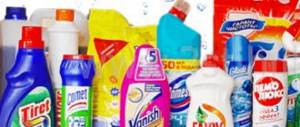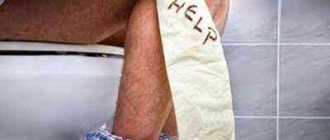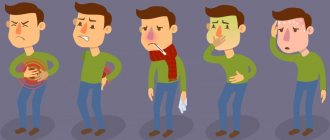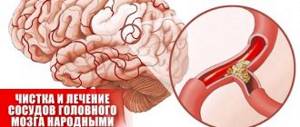Poisoning with chemical reagents and substances can occur under very different circumstances. In most cases, toxic effects are caused by household chemical products (cleaning products, powder, detergents) or harmful types of fertilizers - if used carelessly, as well as medications, dyes and chemical compounds used in production work.
This type of poisoning is considered the most dangerous! And in this article we will look at how first aid should be provided in case of poisoning with chemicals, by what signs this type of intoxication can be recognized, and what scheme (sequence) must be followed in order to preserve the life and health of the poisoned person.
Types of cleaning for disinfection
To clean surfaces from pathogenic microflora and toxins, various disinfectants are used in the form of liquids, aerosols and powders. They are usually used for the following types of cleaning:
- Preventive. This includes hand washing and wet cleaning of any premises using detergents and cleaning products. It is advisable to carry out this type of cleaning in the house every day to prevent household members from becoming infected with dangerous diseases.
- Current. It is usually carried out in medical institutions. All hard surfaces, as well as common areas and medical facilities, are subject to disinfection. inventory. Along with quartz treatment, sanitation with the use of disinfectants prevents the spread of nosocomial infections.
- Final. The most thorough cleaning in medical institutions, which is carried out in wards after the death of patients or the end of isolation. It is performed using strong disinfectants that are effective against most bacteria and viruses.
In everyday life, the first type of cleaning is usually carried out, but contact with disinfectants in a medical institution, pharmacy, as well as public places after sanitation is not excluded.
Solvents and hydrocarbons
Gasoline, kerosene, turpentine, acetone, ether are solvents that are usually used in everyday life. These are volatile components, so they enter the body through the respiratory tract with inhalation of vapors or are absorbed into the blood through the skin.
The components act on the central nervous system, respiratory and cardiovascular systems, kidneys, and liver. This manifests itself in the form of drug intoxication and similar states. In case of chemical poisoning. substances, first aid in this case is as follows:
- need fresh air;
- the skin is washed with soap and the eyes with clean water;
- Absorbents and laxatives are taken to block and remove toxins.
To avoid harm, you must not:
- Drink milk, warm sweet tea or eat butter, as the absorption of poisons only accelerates.
- Induce vomiting if gasoline poisoning occurs, because this aggravates the situation.
Popular groups of disinfectants
The modern chemical industry produces a colossal number of types of products with antiseptic properties. All of them can be divided into the following most common groups, containing:
- Chlorine. Effective against bacterial, fungal, viral microflora. When it comes into contact with metal, it causes its destruction, and when it comes into contact with fabric, it discolors it. They are considered the most affordable and effective in disinfecting hard surfaces.
- Hydrogen peroxide and peracids. These are the least toxic solutions, do not have a corrosive odor, and do not have a detrimental effect on nature. All ingredients of such products decompose very quickly. The purpose of this group of disinfectants is to gently treat stainless steel, plastic, and glass.
- Aldehydes. Effective preparations for the destruction of fungi and microorganisms, characterized by high penetrating ability. Their advantage is the absence of destructive effects on fabrics and metals.
- Phenyl. The peculiarity of the disinfectant effect is the formation of a protective film on the treated surface, on which microorganisms do not settle (prolonged action).
- Alcohol. The most popular category of drugs used to treat hands and skin areas in preparation for injection.
- Quaternary amines. A category of liquid preparations intended for professional sanitation of hard surfaces and equipment. Their toxicity is low, as is their effectiveness against the most resistant groups of microorganisms.
- Organic. A group of solutions used for disinfection of equipment, including hemodialysis systems, is very popular in the medical field.
- Derivatives of tertiary amines. Usually included in detergents, they are not highly toxic, but are effective against most pathogenic bacteria, viruses and fungi.
- Guanidines. Due to their very low toxicity, they are widely used in the food industry; they form an indelible film on treated surfaces.
- Combined preparations are the most dangerous from the point of view of the risk of poisoning, as they contain several different disinfecting components.
Signs of poisoning
If you receive a dangerous dose of a toxic substance, the consequences may not appear immediately. The following symptoms of mild poisoning are distinguished:
- increase in body temperature up to +37°C;
- soreness in the nasopharynx;
- dizziness;
- a small amount of nasal discharge;
- headache;
- nausea with vomiting;
- nose bleed;
- increased salivation;
- general malaise in a mild form, making it difficult, but not preventing 100% performance of usual activities.
With such signs, the victim can provide first aid on his own (if we are talking about an adult). In case of more severe poisoning, the help of others will be required, as well as an immediate call for an ambulance. To hesitate in such a situation is life-threatening.
Symptoms of severe poisoning:
- pronounced irritation in the mucous membranes of the mouth, nose, eyes;
- pain in the larynx and stomach when swallowing;
- foaming from the mouth;
- difficulty breathing until it stops;
- persistent dry cough;
- cramps of the arms and legs;
- chest pain;
- visually clearly noticeable swelling of blood vessels in open areas of the body;
- fainting.
The danger of poisoning caused by aggressive chemicals is their destructive effect on the nervous system. The victim exhibits either increased excitability or unnatural calm. Typical external manifestations of intoxication will allow you to suspect something is wrong: reddened skin, eyes, lips, nose, increased lacrimation and itchy skin.
Some people, due to their profession, have to work with various disinfectants every day. They are at risk of chronic intoxication. It manifests itself with the following signs:
- persistent general malaise;
- painful dry cough that does not stop for months;
- depressed mental state turning into disorder;
- cramps of the arms and legs.
How exactly antiseptic poisoning will manifest itself depends on the type of toxic substance, its dosage and the duration of exposure to the body. It is enough to inhale some substances in small concentrations to burn the mucous membrane of the nose and larynx with antiseptic vapors. Only timely first aid can prevent serious complications.
How to help the victim?
The first thing to do when identifying signs of poisoning is to find out the name of the drug. Based on the information received, the appropriate type of emergency care is used:
- The eyes were damaged. You should wash your face and eyes with plenty of running water or a weak solution of soda ash. It is allowed to use albucid or other anesthetic for instillation into the eyes in accordance with its instructions.
- A dangerous substance has entered the mouth. Give the victim a large amount of clean water or a weak solution of potassium permanganate (you can give a solution of baking soda, milk or ammonia - up to 20 drops per 200 ml of water) to provoke vomiting. If a product with an acidic or foaming composition is swallowed, then before the doctor arrives, activated charcoal should be given without inducing vomiting.
- The substance got into the nasal mucosa and caused bleeding. You should lay the victim on his back, raise his head and apply a cold compress to the bridge of his nose.
- The antiseptic got on the skin and caused irritation. This happens even when using the usual hand sanitizer. In this case, wash the damaged area with clean water (or with laundry soap). To relieve redness, you can use a drug intended for the treatment of chemical burns (as recommended by a doctor).
Sometimes, when poisoning with antiseptics, respiratory arrest occurs. To provide first aid, a person is first placed on his back and his head is raised slightly, trying to push the lower jaw forward to free the trachea. It is necessary to immediately restore the ability to breathe; for this, the victim is given artificial respiration and chest compressions.
If the victim can move independently, then he is taken out of the room into fresh air, trying to free him from soiled clothing and clean open areas of the body from antiseptic residues.
Children, along with adults, are at risk of being poisoned by disinfectants. To alleviate the child’s condition before the ambulance arrives, you should:
- Give a glass of warm milk with your usual anti-allergy remedy.
- Rinse the damaged area of skin and/or mucous membranes.
- When swallowing a liquid antiseptic solution, you should try to induce vomiting, controlling the process to avoid choking.
Health care
The arriving ambulance team needs to tell you where the person went, what his first symptoms were, and what kind of help you provided him. Having assessed all the information provided, doctors will determine what scheme should be used to provide first aid.
The following assistance can be provided to a poisoned person:
- connection to a device for artificial ventilation of the pulmonary system;
- intubation - insertion of a special endotrachial tube into the trachea to improve airway patency;
- gastric lavage through a tube;
- administration (intravenously) of medication solutions to improve the functioning of the heart, blood vessels and respiratory system.
Hospitalization is carried out as quickly as possible, transporting the patient to the toxicology department.
What complications can there be?
After a short or very long time after poisoning with an antiseptic, the victim may experience various consequences:
- myocardial dystrophy;
- liver damage;
- kidney inflammation;
- bronchitis, pneumonia;
- chronic pathologies of the lungs and heart;
- psoriasis;
- eczema;
- dermatitis;
- polyneuritis;
- spinal cord damage.
Poisoning of pregnant women is especially dangerous, as it will lead to detrimental consequences for the health of the fetus (miscarriage is possible).
Alcohol
This is ethyl alcohol. It has different concentrations in different drinks. Alcohol acts on the central nervous system as a neurotoxin and causes damage to the liver, kidneys, and heart. Alcohol substitutes – alcohol-containing household chemicals and perfumes – are dangerous. Methyl alcohol leads to fatal poisoning or irreparable consequences such as blindness and deafness.
The departure manifests itself in the form of a characteristic odor, unconsciousness or coma, and a weak thread-like pulse. The temperature drops sharply and sticky sweat appears, convulsions appear, and the pupils constrict. First aid for poisoning with chemicals of this type is as follows:
- Gastric lavage is performed.
- The poisoned person is given ammonia to smell.
- It is necessary to provide access to fresh air.
- Be sure to give absorbents.
- The body needs to provide warmth.
Prevention measures
The first means of protection against poisoning by a disinfectant is to follow the manufacturer's instructions. In addition, follow the general safety rules:
- Household chemicals should be stored in a dark place inaccessible to children and strangers. If a substance is transferred from its original packaging, it must be marked accordingly.
- You should work with antiseptic in a ventilated area.
- After disinfecting surfaces, any remaining antiseptic should be removed from them.
- When working with disinfectants, use all necessary protective equipment: respirator, apron, rubber gloves.
There must be a first aid kit in your home (workplace) with first aid supplies for chemical poisoning.
Chemical vapors
First aid for chemical poisoning depends on the type of exposure. As a result of inhalation of toxic components, damage to the upper respiratory tract occurs. This appears as:
- shortness of breath;
- cough;
- acute respiratory failure;
- chemical burn of the upper respiratory tract;
- noticeable pallor or bluish tint to the skin;
- watery or dry eyes;
- disorientation, hallucinations;
- loss of consciousness;
- changes in the rhythm of the heart.











